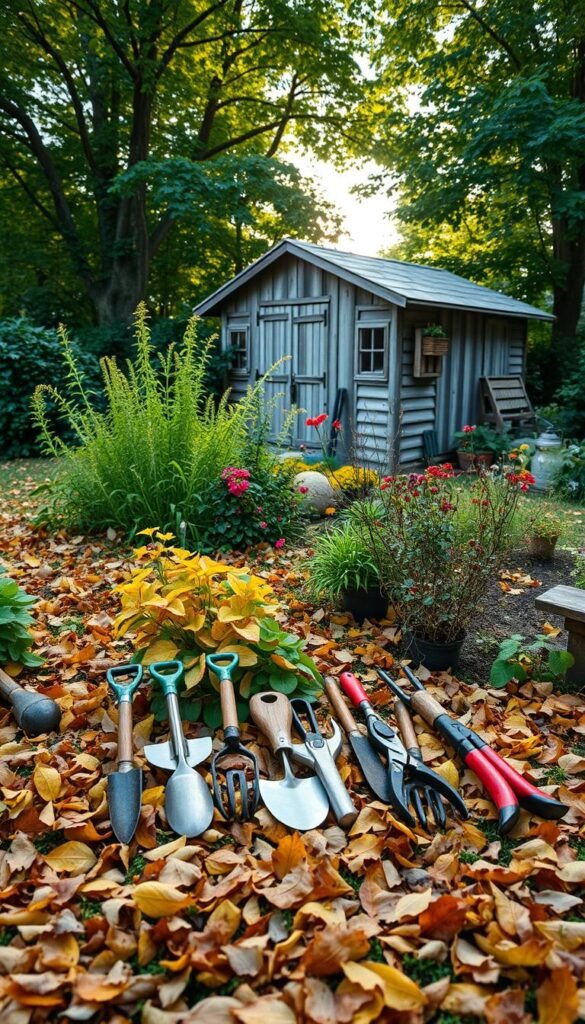Starting your first growing space can feel like solving a puzzle with missing pieces. Seasonal rhythms hold the key to building confidence without overwhelm. Many new growers spend years figuring out when to plant tomatoes or prune roses – but you can shortcut that process with a structured approach.
This method works across regions from the Midwest to the Northeast (zones 4-8). You’ll learn to balance indoor seed-starting with outdoor maintenance while growing flowers, herbs, and veggies. Think of it as nature’s calendar – one that helps you stay ahead of frost dates and harvest windows.
Why take notes and photos? Your unique space evolves yearly. Last summer’s tomato success or that unexpected June storm? Both become valuable lessons. This isn’t about rigid rules but creating flexible habits that adapt to your soil, climate, and goals.
We focus on earth-friendly techniques that conserve water and support pollinators. Whether you’re nurturing basil on a balcony or transforming a backyard, seasonal timing transforms chaos into progress. Ready to grow more than plants? Let’s cultivate skills that bloom year after year.
Understanding Seasonal Garden Tasks
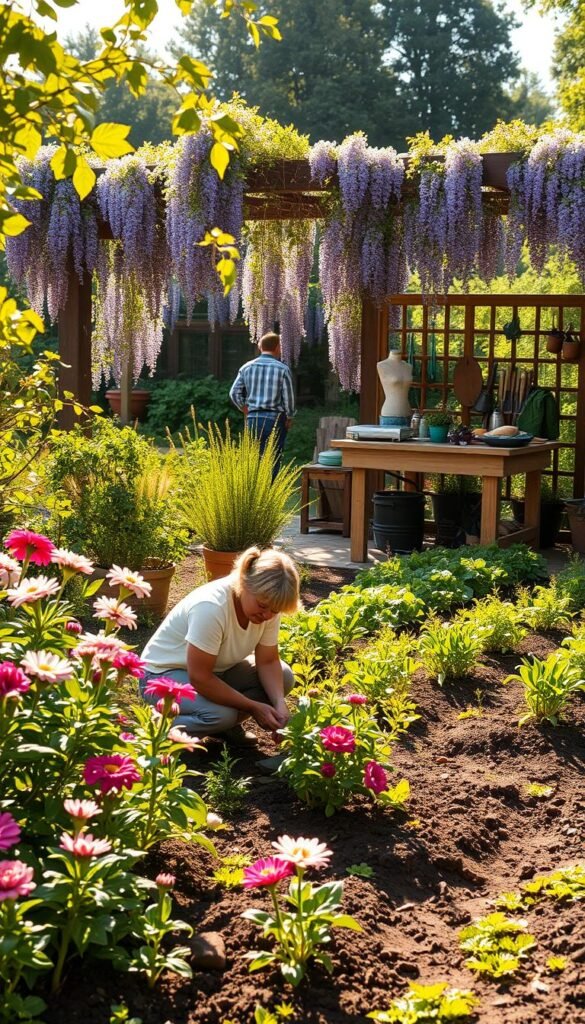
Plants thrive when you sync your efforts with their biological clocks. Soil warmth tells you more than any date on your phone – stick your finger in the earth to gauge readiness. Consistent 60°F temperatures at root level signal prime sowing time for most seeds, letting you avoid wasted effort.
Why Seasonality Matters in Gardening
Your local seasonal care strategies determine success more than generic advice. Early frosts can wipe out tender seedlings, while delayed planting shortens your harvest window. Nature rewards those who watch weather patterns, not just calendars.
Zone maps aren’t arbitrary numbers – they’re survival guides. A zone 5 gardener starts tomatoes indoors weeks before their zone 7 neighbor. Track soil temps with a $10 thermometer to nail transplant timing.
Aligning Your Tasks With Local Climate
Microclimates matter too. South-facing walls warm faster than shaded beds, creating staggered planting opportunities. Observe where snow melts first – those spots work for early greens.
Protect your work by completing tasks 7-10 days before last frost dates. This buffer handles unexpected cold snaps. Your growing season length dictates crop choices – 90-day watermelons fail where frost comes early.
Remember: Plants adapt slowly. Sudden heat waves stress transplants more than gradual warming. Use row covers as training wheels while seedlings adjust to outdoor life.
Winter Garden Strategies and Preparations
Cold months offer hidden opportunities to set up success for warmer days. While snow blankets the ground, your indoor space becomes a launchpad for next year’s harvest. This quiet period lets you refine systems and protect investments before spring’s rush.
Indoor Seed Starting and Tool Maintenance
Grow lights transform spare rooms into nurseries for tomatoes and peppers. Start seeds 6-8 weeks before last frost using sterile trays and moisture-control soil. Pro tip: Label containers with planting dates to track growth rates.
Sharpen pruners and oil hinges while tools rest. A simple vinegar soak removes rust from trowels. Organize supplies by season – keep frost blankets handy until temperatures stabilize.
“Winter planning turns guesswork into strategy. My seed spreadsheet ensures I never overbuy basil or underestimate kale timelines.”
Monitoring Frost and Protecting Plants
Use wireless thermometers to track overnight lows near tender plants. When forecasts dip below freezing:
- Water containers before sunset – moist soil holds heat better
- Drape row covers over raised beds by 3 PM
- Move potted citrus into garages temporarily
| Task | Timing | Tools Needed |
|---|---|---|
| Seed Starting | Jan-Mar | Grow lights, heat mats |
| Tool Maintenance | Dec-Feb | Sharpener, lubricant |
| Frost Monitoring | Nov-Mar | Wireless thermometer |
| Plant Protection | When below 32°F | Frost cloth, cloches |
Check stored bulbs monthly for mold. Mice avoid metal containers – upgrade from cardboard seed boxes. Vent cold frames on sunny days to prevent overheating dormant greens.
Spring Garden Preparation and Soil Management
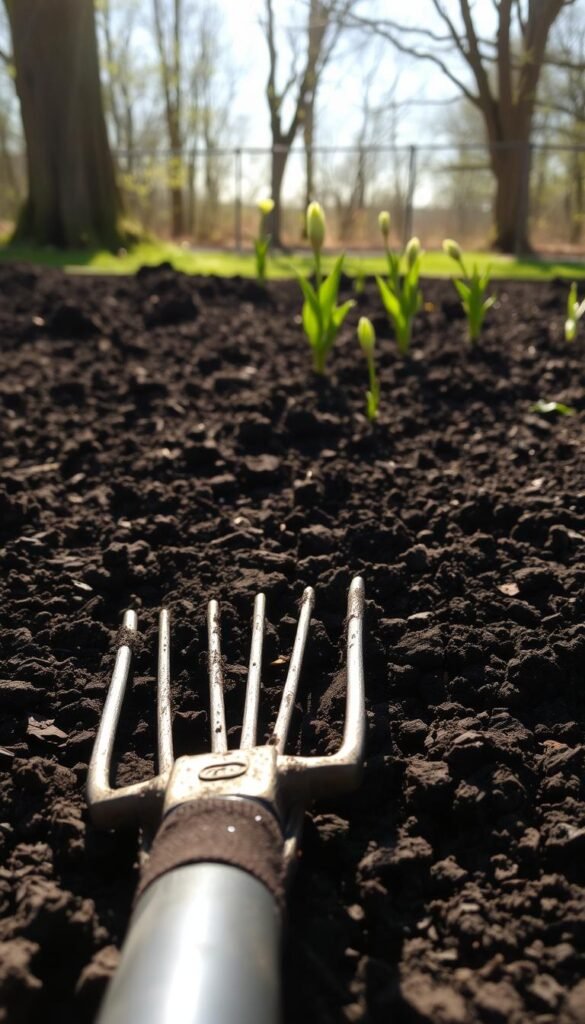
Spring’s arrival brings renewed energy to your growing space. This critical window lets you establish healthy foundations while avoiding common pitfalls. Your success hinges on reading nature’s signals rather than chasing arbitrary dates.
Soil Testing and Amending Your Garden Beds
Mid-spring offers the perfect moment to test your earth’s health. Home test kits reveal pH levels and nutrient gaps while there’s still time to adjust. Squeeze a handful of dirt – if it forms a muddy ball, wait until it crumbles easily before working.
Amendments work best when mixed 4-6 weeks before planting. Add compost to heavy clay or sand to improve drainage. One gardener notes: “Balanced soil grows stronger plants with fewer pests – it’s worth the effort.”
| Spring Task | Best Timing | Key Supplies |
|---|---|---|
| Soil Testing | Mid-spring | Test kit, compost |
| Bed Preparation | 45°F soil temp | Broadfork, rake |
| Amendment Mixing | 4 weeks pre-plant | Worm castings |
Dividing Perennials and Early Planting Tips
Overcrowded blooms? Early spring dormancy makes dividing easier. Dig up clumps after new shoots appear but before flowering. Replant divisions immediately, keeping roots moist.
Follow these guidelines for cold-sensitive starts:
- Wait for consistent 45°F soil temps
- Use black plastic to warm beds faster
- Protect seedlings with cloches
Clear winter debris to expose soil to sunlight. This simple step jumpstarts microbial activity while reducing slug habitats. Your careful prep now leads to thriving plants all season.
Garden Planning for Beginners: Breaking Down Tasks by Season
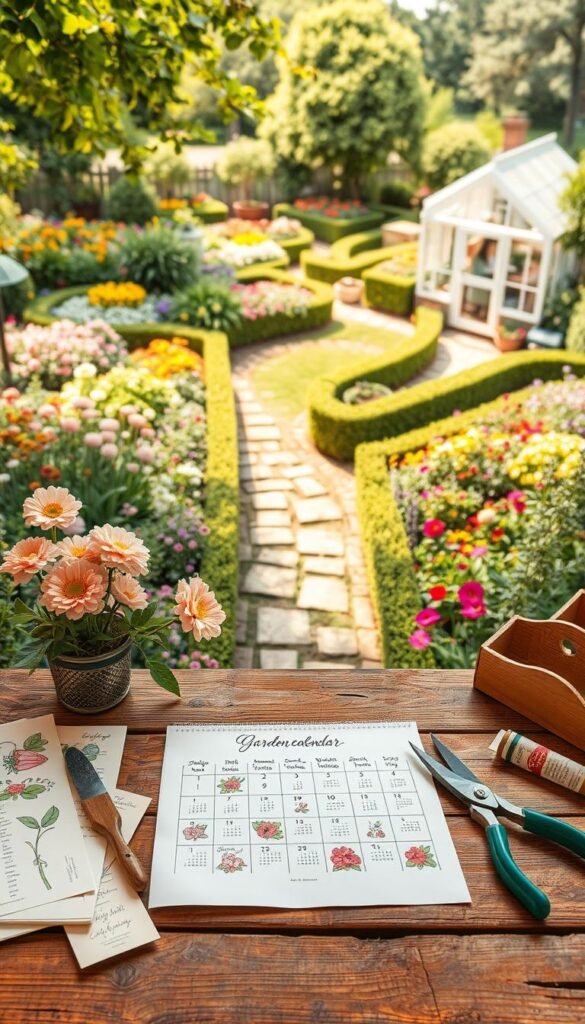
Timing separates thriving plots from chaotic patches. Winter’s quiet weeks offer the perfect chance to design a custom calendar that aligns with your family’s meals and local weather patterns. Grab last year’s notes while memories of bumper crops and stubborn pests remain fresh.
Online seed calculators take the guesswork out of scheduling. Plug in your average last frost date to get precise sowing dates for tomatoes, peppers, and other favorites. One grower shares: “Mapping my planting dates saved 3 hours weekly – no more frantic Google searches!”
Balance flexibility with structure using these strategies:
- Color-code your calendar by crop type (leafy greens vs root veggies)
- Leave blank spaces for unexpected seedlings or weather delays
- Set phone reminders 7 days before transplant deadlines
| Planning Task | Ideal Month | Essential Tools |
|---|---|---|
| Seed Schedule Creation | January | Frost date map |
| Crop Rotation Layout | February | Grid paper |
| Succession Planting Plan | March | Seed packets |
| Harvest Timeline | April | Weather app |
Track what worked each season in a dedicated journal. Did basil outgrow its space? Note it! Over time, these insights create a personalized playbook that respects your soil, climate, and lifestyle. Remember: Great calendars evolve – just like your skills.
Mid-Spring and Early Summer Action Steps
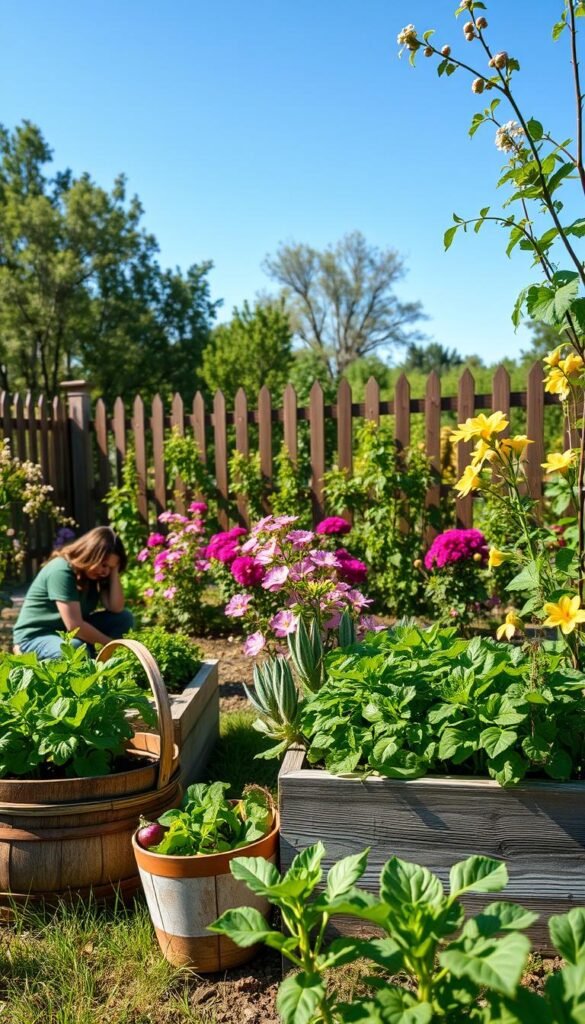
Your seedlings’ big move outdoors requires careful timing and technique. Start hardening off plants 14 days before transplanting – this gradual exposure to sunlight and wind prevents leaf scorch. Begin with 1-hour outdoor sessions in shade, increasing daily until they handle full sun.
Hardening Off Seedlings and Transplanting Techniques
Transplant on cloudy mornings to reduce stress. Gently loosen roots without breaking the soil ball – damaged roots delay growth by 2-3 weeks. Water thoroughly after planting, keeping soil moist but not soggy for the first 5 days.
“I use old milk jugs as mini-greenhouses for tender starts. Cut the bottom, remove the cap, and you’ve got instant frost protection.”
Implementing Irrigation and Mulching Strategies
Install drip lines before plants mature to avoid disturbing roots. Pair with rain barrels to collect spring showers – this setup cuts summer water use by 40%. Apply 3 inches of straw mulch around veggies once soil warms, keeping it away from stems.
| Task | Timeline | Materials |
|---|---|---|
| Begin hardening off | 14 days pre-transplant | Shade cloth |
| Install irrigation | After last frost | Drip lines, timer |
| Apply mulch | Soil reaches 60°F | Straw, wood chips |
Avoid common small-space mistakes by planning hose routes early. Remove frost cloths when night temps stay above 50°F – plants need unfiltered light during peak growing season.
Summer Garden Care and Maintenance
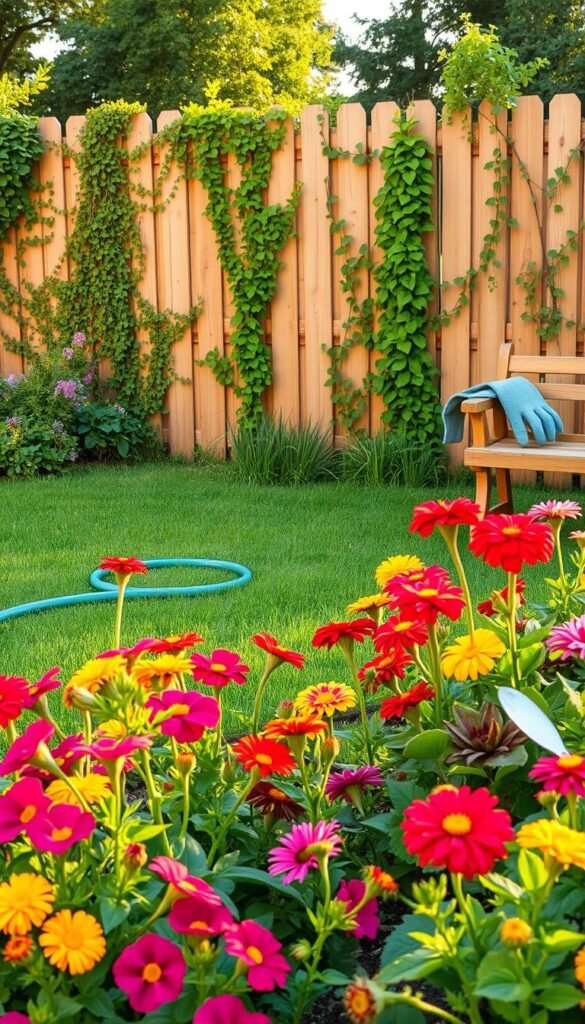
Your green space becomes a productivity powerhouse during summer’s golden hours. The warmest months demand smart routines that keep plants thriving without turning care into a chore. Balance becomes essential – too much water drowns roots, while too little invites stress.
Watering Techniques and Handling Pests
Deep soak plants before 9 AM using drip lines or soaker hoses. This method delivers moisture straight to roots while reducing evaporation. One grower notes: “Morning watering sessions cut my slug population by half – they avoid dry foliage at night.”
Combat common invaders with these strategies:
- Blast aphids off leaves with a hose spray
- Handpick Japanese beetles into soapy water at dawn
- Place beer traps near slug-prone vegetables
Rotate organic sprays weekly to prevent pest resistance. Neem oil works best when applied in cooler evening hours. Always check undersides of leaves – that’s where trouble starts.
Succession Plantings and Harvest Management
Keep your essential tools ready for repeat sowings. Sow fast-growing crops like arugula every 14 days for nonstop salads. Use this planting guide:
| Crop | Days to Harvest | Ideal Soil Temp |
|---|---|---|
| Bush beans | 50-55 | 70°F |
| Radishes | 25-30 | 65°F |
| Spinach | 35-40 | 60°F |
Harvest daily to encourage new growth. Twist tomatoes gently upward to avoid stem damage. Store picked produce in shaded baskets – direct sun softens veggies within minutes.
Refresh soil between plantings with compost tea. This gives late-summer crops the boost they need to outpace fall frosts. Remember: Consistent care now means abundant harvests later.
Fall Garden Preparation and Transition
Cooler air signals nature’s shift from growth to restoration. This season lets you secure next year’s success while honoring your soil’s need for recovery. September’s cooling soil becomes your canvas for spring surprises and protective measures.
Planting Bulbs and Preparing Cover Crops
Bulbs demand precise timing – plant them 6 weeks before hard frosts while soil remains workable. Tulips and daffodils thrive when set at depths triple their height. Pair with garlic cloves, pointed end up, for dual-purpose beds.
Cover crops like clover or winter rye prevent erosion. Sow them in empty spaces – their roots break up compacted earth while adding nitrogen. One grower shares: “My soil improved more in one winter with rye than three years of bagged fertilizers.”
Mulching, Pruning, and Cleanup
Apply mulch after first freeze to insulate roots without inviting rodents. Shredded leaves mixed with straw create breathable blankets for trees and shrubs. Avoid piling material against stems to prevent rot.
Prune dead branches but leave healthy growth intact. Diseased foliage belongs in trash bags, not compost. Sanitize tools between cuts to stop pathogen spread.
- Divide peonies when leaves yellow but before dormancy
- Leave seed heads for birds and overwintering insects
- Top-dress beds with finished compost before snowfalls
Your fall efforts create ripple effects. Well-tended soil wakes up hungry in spring, while dormant bulbs await their curtain call. Every raked leaf and buried clove builds resilience for seasons ahead.
Monthly Garden Checklists and Timelines
Organizing your green space becomes simpler with monthly guides. These calendars act as cheat sheets, helping you stay ahead without memorizing every detail. Let’s explore how structured checklists adapt to your unique growing conditions.
Detailed Month-by-Month Task Breakdown
January brings crisp opportunities. Harvest cold-loving crops like kale or Brussels sprouts from raised beds. Order seeds while suppliers have full stock. Test stored garlic bulbs and forced daffodils for mold – healthy starts matter.
February shifts focus to structure. Prune fruit trees before buds swell. Sharpen tools and test old seeds for germination rates. This quiet time lets you refine layouts using last year’s notes.
Adjusting Tasks Based on Local Frost Dates and Regions
Your first frost date dictates success. Coastal growers prune earlier than mountain dwellers. Track microclimate variations – south-facing slopes warm faster for early spinach plantings.
Pair regional knowledge with flexible checklists. If winters stay mild, extend harvests of winter crops into March. Adjust seed-starting dates by counting backward from local frost averages.
Keep tasks practical. Midwest gardeners might transplant tomatoes in May, while Southerners start in April. Your monthly roadmap evolves as you balance nature’s signals with hands-on experience.

